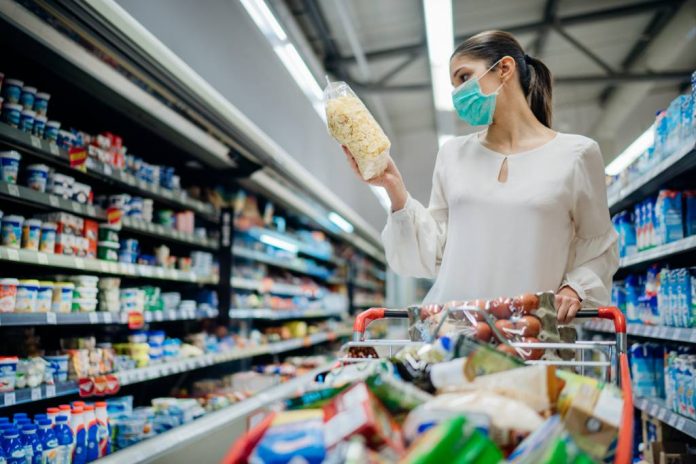It started with a phone call from a doctor—or rather, the expectation of one.
“Within a month of the start of the COVID crisis,” said David Williams, EVP of Business Development at Cornerstone Consulting, “we had to go to Costco, and I was waiting for an important phone call from a doctor. I said to my wife, ‘I’m not going to touch anything, because I’m going to have to touch my phone’—which would then, you know, have to touch my face. Because of that, I was hyperaware of everything around me, and I was watching people touch every product—turning it around, picking it up, to read the label. And in the natural product space, we love that, we want people to read labels. But if you pick up an item and decide you don’t want it and put it down, everything that was on the first product will be on the next product you touch—so even if you’re wearing gloves and a mask and you never touch your face, you’re still spreading it. As a bit of a germophobe, this is horrible to me on a good day. It’s much worse during COVID.”
This kind of spread, Williams says, is common sense. “If people touch it less, COVID will spread less,” Williams told WholeFoods. The CDC said COVID will last 24 hours on cardboard—because these products are being handled so frequently, you can almost see it happen.” And people are handling products more often than ever: “The products they normally buy aren’t available. So they’re looking somewhere else. ‘Instead of brand A, I’m going to grab brand B’—and now they start looking at labels. ‘This has too much sodium, this isn’t paleo.’ We’re trying and touching things more than ever before. And people are changing their eating habits, because they want to be healthier—all the more reason they are looking at labels.”
This isn’t just speculation on Williams’ part; he cites a study from C+R Research which found that, due to COVID-19:
- 88% of shoppers are unable to find certain items they normally buy
- 76% of shoppers are not buying brands they normally buy
- 47% of shoppers have changed their diets or eating habits.
“I felt like this was the perfect convergence of: no one should be touching this stuff until they’re ready to buy it, people are changing their dietary habits, and people are afraid to go to the doctor’s—if you don’t have COVID, you’re not going to the doctors, so people are going to natural product stores, and products are being handled a lot more. I thought that that convergence meant something,” Williams said.
So Williams created a solution: Touch-Less Aisle Browsing. Touchless Aisle Browsing uses ELI Codes: They’re similar to QR codes, so customers will understand how to use them—but whereas QR codes, Williams explains, are directions for the phone, ELI codes are also the back end that the directions lead to. QR codes may direct people to a website, but the person who purchased the QR code also has to go purchase and build the website; ELI codes come with that back end work built-in. QR codes are a driveway; ELI codes put the house at the end of that driveway. It’s easier, Williams says, on the creator’s end. And in grocery stores right now, it can make a big difference: If people can point their phone at an ELI code and get the label information, then they don’t have to pick up the product, find the nutrition facts, decide it’s not for them, and put it back, facilitating the spread of germs.
Even ignoring that, Williams says this could be a good move for grocery stores to make. He refers back to that C+R Research study, which found that:
- 60% of shoppers are scared to shop at a grocery store
- 60% feel a sense of panic or anxiety while shopping
- 35% believe grocery stores are not doing enough to protect customers from coronavirus
- 50% believe grocery stores are not doing enough to protect employees from coronavirus
- 45% of shoppers disinfect groceries before bringing them home
A measure like ELI codes can help mitigate all that fear, by allowing people to touch fewer products.
Related: ABC: Record-Breaking Herbal Sales Predicted for 2020
Survey Reveals Consumer Labeling Preferences
The Natural View: How Retailers, Brands, and Suppliers Can Gain a Competitive Edge with ELI Codes
Williams also points to the potential for these codes: “Besides nutrition facts, people can add information—videos, research, anything. It can be like online shopping, in-store.”
Grocery stores—like Fresh Thyme—agree. In an announcement to vendors, the grocer said that they will be adding ELI codes to their shelf tags beginning in November to “help shoppers make better-informed buying decisions in-store while allowing our supplier partners to provide digital content to best present their products to our shoppers.” It will serve the bonus purpose, the press release says, of helping to educate Fresh Thyme’s employees. Fresh Thyme asked their vendors to upgrade the content included in their ELI codes to include videos, PDFs, links to websites, and more, to best show off their products.
The takeaway: “We’ve seen the codes being scanned, we know they’re being scanned,” Williams told WholeFoods. “The interesting thing for us has been the response that people have given to retailers who use this. You see the things retailers are doing—wiping down cart handles, plexiglass, pinpads, the belt at the register. They’re ignoring everything else you’re touching in the store—the products. You can’t spray boxes of cereal with Lysol, though. People are amazed when you take that step, add these tags—they go up to store personnel and say ‘wow, this was a great idea.’”

